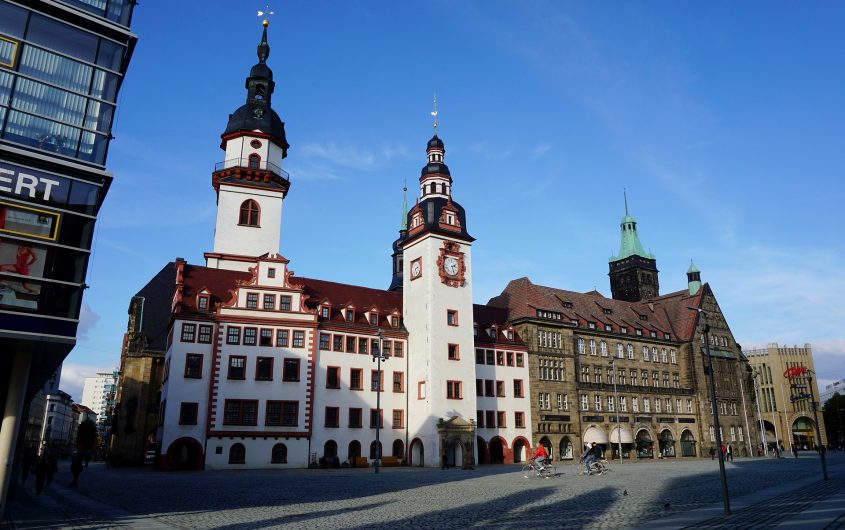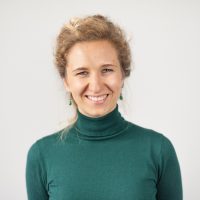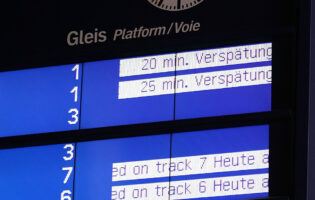
Sandro Schmalfuß via Wikimedia Commons
Chemnitz: A city on the verge of social division and social cohesion

Dillon Cathro
University of Michigan School of Social Work
Dillon Alexander Methven Cathro provides diversity, equity and inclusion education and training to organizations in the DeKalb region and beyond. His primary goal is to foster connections with various organizations on the corporate and community levels in the region, and to work with them to foster work environments that center diversity, equity and inclusion in their strategic models. The only child of a single mother, and the product of a community-based approach to child-raising, Dillon has a passion for helping community members to seek out and access academic, professional and social resources on and off campus. Coming to NIU with professional experience in education, social work and community organizing, Dillon is clear and transparent in his mission to combat systemic injustices and looks forward to supporting community leaders throughout Dekalb County as they cultivate the skills and tools necessary to instill sustainable and equitable social change throughout their communities.

Elizaveta Firsova
Institute for Didactics of Democracy
Elizaveta Firsova is a research associate and PhD student at the Institute for Didactics of Democracy at Leibniz University of Hanover. Ms. Firsova holds a Master of Arts in Education Studies from Freie Universität Berlin and has focused on the role of education in combatting social division, especially regarding immigrant communities. After her graduation, she worked for "PROOF: Media for Social Justice" in New York City, on curricula in the field of social justice. Currently, Ms. Firsova is a project coordinator for initiatives funded by the European Union to tackle social divisions on different levels. In one project, she focuses on bringing digital media literacy to schools with predominantly disadvantaged students, and in her second project, she is designing a program to target extremism and conspiracy theories in adult education institutions. In her PhD thesis, Ms. Firsova researches the impact of the Israeli-German youth exchange program on participants' political views regarding the Israeli-Palestinian conflict.
After two years of the pandemic, the AGI group of the Social Divisions and Questions of Identity in Germany and the United States project reunited in Chemnitz for the second part of the project. In Chemnitz, located in the German federal state of Saxony, the project group investigated the status quo of social divisions in Chemnitz after first meeting in Akron in 2019.
The former East German city was called Karl-Marx-Stadt from 1953 to 1990—a name chosen by East Germany’s then-ruling Socialist Unity Party to commemorate one of the founding fathers of socialism. Before and during the socialist era, the city was the center of a flourishing industry. However, nowadays the image of the city, especially presented by the media, is less characterized by a vivid economy and more shaped by a picture of economic frustration which leads to an increase in internal migration from former East Germany to the former West, an increase in xenophobic and anti-Semitic violence, and an aging population.
In Chemnitz, our picture of the city became more multilayered, fueled by input from many different individuals, NGOs, and institutions. By outlining the four most perceptible dimensions of division that we witnessed in Chemnitz, we would like to share the picture of a city that has many challenges to face but has also done much to tackle them in a productive way.
A city between economic frustration and economic transformation
As a former East German city, Chemnitz suffered a geographical disadvantage by design. The GDR economy was characterized by large industrial projects, and Chemnitz was a major industrial center. With the economic upheaval following the reunification of East and West Germany, the Wendezeit, these large industrial enterprises were lost in East Germany. Once a country-renowned hub for auto, steel, and textile production, the continuous reallocation of the city’s infrastructure and industrial resources during the GDR, as well as the large-scale divestment from greater East Germany in the aftermath of reunification left many feeling that Chemnitz was now a ghost of its former self. This then led to a continuous exodus of young people from Chemnitz toward larger cities that offered more work opportunities. We therefore witnessed, as visitors to the city, a dual crisis of identity caused by a recent history of both economic and social divestment from the city.
In response to the low numbers of young people choosing to stay in Chemnitz, the city has in recent years made strides to rejuvenate its industrial and entrepreneurial sectors in an attempt to market itself as a fun, lucrative, and culturally rich place to live. For example, in partnership with the Chemnitz University of Technology, the city has renovated former GDR buildings and repurposed them as student dorms, with prices often capped at 300-400 euros a month (roughly $320-$430 a month). Moreover, office spaces are being made available for rent and sale to entice young people with startups and entrepreneurial ventures to take advantage of low prices and set up shop in the city. However, these initiatives are still in their fledgling stages and therefore it is too early to determine how well the city is doing to reinvigorate the economy and attract new talent to the city.
A city that is “out of reach”
The economic detachment seems to correlate with a detachment in mobility. According to a 2019 study by the German newspaper DER SPIEGEL, there are big differences between cities in the former East and the former West: The East seems to be clearly left behind as far as rail traffic is concerned. While the general decline in Germany of long-distance train departures between 1988 and 2018 affected 68 percent of the west German cities, 95 percent of the former East German cities were among the losers.
This also matches our perception of the accessibility of Chemnitz. We witnessed first-hand long layovers in Leipzig arriving from the capital city Berlin or from Leipzig Airport, leaving the impression that long-distance traffic is not coordinated between Chemnitz and other major German cities. Our interview partners, especially young academics, confirmed this impression and described a town that struggles with accessibility. For example, a professor at the University of Chemnitz stated that he (and many of his colleagues) prefers to live in Leipzig since the city is better connected to other important cities and the airport. Even though Chemnitz has a university that offers a diverse set of education pathways and manages to attract students from all over Germany and numerous international students, our interview partners pointed out multiple times that Chemnitz fails to entice students to stay after graduation and loses young professionals to cities that promise vivid cultural lifestyles, like Leipzig and Berlin, or a historical and scenic city-landscape, like Dresden.
However, those interview partners who decided to stay in Chemnitz highlighted the city’s benefits: For example, our city tour guide, who was proud to be a “true Chemnitzer,” pointed out that the city manages to keep the coziness of a small town—despite its 244,400 inhabitants that formally make it a metropolitan city. At the same time, Chemnitz does have the advantages of a bigger town, such as an established university, cinemas, shopping malls, and a varied nightlife. Chemnitz’s university attracts students from all over the globe, giving it an international feel, The city’s affordable housing is a draw, considering that rents in most university towns are exploding all over Germany.
A city struggling with right-wing movements
Chemnitz’s far-right citizens have attracted negative headlines in the national and international press. Right-wing protests in Chemnitz, which were also accompanied by violent riots, became very visible after Germany accepted Syrian refugees in 2015, and they still occur today. In the past, organized right-wing groups and neo-Nazis from Chemnitz attacked immigrants, anti-racism-protestors, police officers, and members of the press as well as the Jewish restaurant Shalom in 2018. The owner of the restaurant described that his daughter was traumatized by the 2018 attack when the attackers also shouted anti-Semitic chants. However, he is not afraid of the radical group that he described as a loud minority but not representative of the population of Chemnitz.
However, the right-wing shift in Chemnitz is also noticeable when looking at the distribution of the seats in the city council: with 16 seats out of 60, representatives of right-wing and far-right parties hold over 25 percent of the seats. This mirrors the result of the 2021 federal election in the state of Saxony, where the Alternative for Germany (AfD), the biggest German right-wing party, achieved the best election result (25 percent). In contrast, the AfD’s best election result in a former West German state was estimated at 10 percent in Saarland.
Despite those numbers, the people that we met in Chemnitz conveyed a slightly different picture. Among others, we met the team of the intercultural education initiative AGIUA e.V., a cultural and educational meeting space that tries to bring people of different backgrounds together. In our conversation, the team stated that they hadn’t experienced any disruptions or acts of aggression carried out by right-wing individuals or groups.
A city caught between the problem of an aging population and the need for newcomers
As evidenced by the above paragraphs, the city of Chemnitz has been in a chronic state of ebb and flow in the industry, education, and social sectors. This crisis of identity, the never-ending struggle to acquire a sense of oneness or unity within the city’s parameters, contributed to the social divisions that our group witnessed during our time together. Based on what we heard from the employees at AGIUA, as well as the Press Officer of Chemnitz, the divide between the aging and younger populations was palpable: many young people we spoke with, whether they were longtime residents of Germany or recent migrants, had dreams to venture to more well-known cities such as Dresden or Leipzig, or even Berlin and therefore viewed the city of Chemnitz as a stepping stone toward their primary destination. From a social work perspective, one could imagine the feelings of anxiety and loss that residents felt as more and more young people left the city without acquiring an appreciation for what Chemnitz had to offer.
These feelings were further complicated, intensified, and sometimes violently warped, as the number of refugees fleeing violence and war in the city continued to increase. While many of the newcomer residents were young, temporarily able-bodied, and willing to join the workforce as quickly as possible, bureaucratic policies and ethnonationalist pushback posed significant barriers to helping these young people acquire employment or enter the education system in the city of Chemnitz. For example, it is EU migration policy that once a person’s asylum claim has been processed and accepted, a mandatory three-month waiting period follows before the person can acquire a work visa, which means that refugees are unable to receive any form of “legitimate” income for the 90 days following their approved status (and that’s only if their status as a refugee was successfully processed). However, representatives from AGIUA and the Sächsischer Flüchtlingsrat (Refugee Council of Saxony) informed us that even after work visas had been obtained, newcomers in the city were then confronted with various forms of hiring discrimination that toed a fine line of implicit and explicit xenophobia: we heard stories of people being denied employment in Chemnitz because of their level of German language proficiency or because of their refusal to take off their hijab in the workplace. Moreover, we also learned that many young refugees were also turned away from pre-professional training programs that would have prepared them to work in high-need sectors such as senior citizen care, various trades including electricity and plumbing, and early childhood education.
We observed a paradoxical reality in which the city bemoaned the loss of young and brimming talent to bigger, more well-known cities, while also bearing witness to sometimes deliberately missed opportunities to onboard newcomers into the workforce and education systems. This lived reality of so many refugees from the Middle East stands in stark contrast to the expedited processes through which Ukrainian refugees have integrated into those very same workforce and education systems. (Ukrainian refugees fleeing the war in 2022 were allowed to enter the European Union under a temporary protection directive, which allowed them immediate access to education and employment without the usual asylum process and waiting period.) While the willingness of Germany and other EU countries to accept these incoming refugees with open arms is wonderful, the question remains as to whether this current policy of more open acceptance to newcomers will become the standard, or simply the exception for the chosen few? Looking at Chemnitz and cities with similar problems like the aging population and the struggle to establish a new generation of manpower on the labor market, it is precisely these accelerated processes of labor market integration that were shown throughout the last months that provide a crucial potential for productive growth.
How does one make sense of and address such a complex history and system of social divisions? Our group has yet to find a solid, concrete answer; indeed, it is likely necessary to create a repertoire of interventions for these multitudinal problems. However, we were fortunate to meet with several non-profits and community members who have been trying to bring seemingly polarized communities together in order to convene in solidarity with one another. For example, AGIUA provides conversation tables and cultural activities that bring recent immigrants and long-term residents of Germany together to learn from one another and demystify stereotypes or falsehoods that people may have held toward one another. Additionally, Clubkino Siegmar supported the production of a film that explored the experiences of several people that had come to Germany as refugees in the hopes that this film would motivate people from older generations within the community to practice openness and kindness with newcomers in their respective neighborhoods. The film was shown at a local film festival in the fall of 2021 in Chemnitz, and the production crew plans to host viewings and discussions of the film throughout the coming summer and autumn seasons. Finally, we learned from members of The Refugee Council of Saxony that their organization provides case management, educational, and advocacy services to asylum seekers navigating the asylum application process. Their goal is to not only support asylum seekers as they apply for refugee status; they also leverage social and political capital in order to campaign and organize for more human and equitable resettlement processes for stateless and/or nationless peoples. Good work is being done, therefore, to bridge the divide between polarized communities in Chemnitz. And we hope that these community solidarity efforts continue and gain more momentum in the weeks and years to come.
Closing argument: Outlook on Chemnitz?
All in all, our time in Chemnitz was a fruitful one. Not only were we able to identify sources of divisions and tension between different groups, but also had the opportunity to bear witness to community-building and political advocacy efforts that sought to bring people together in solidarity. The issues facing this city, and perhaps the greater state of Saxony, are unfortunately not unique: in other countries around the world, the United States included, long-term economic divestment and political scapegoating of immigrants and refugees are common strategies used to stagnate progressive policy reform. While both countries, among others, have vowed continuously to implement more human-centered approaches to issues such as immigration, social welfare policy, and education, the evidence of their current policies demonstrates that progressive policy reform is still well off into the future. What is unique and hopeful about Chemnitz, though, amidst all the problems we’ve described, is the deep sense of pride and joy many Chemnitzers hold toward their city, and the willingness of so many residents to share the beauty of their city with newcomers. Chemnitz was recently named the European Union Capital of Culture, an honor that will be celebrated with great fanfare in 2025. It is the hope of the authors of this article that in three years, the city will have made even further strides to showcase the cultural richness of its citizenry, long-time residents and newcomers alike, in order to provide a much-needed model for what intentional, equity-minded resettlement and acculturation policies should look like.









